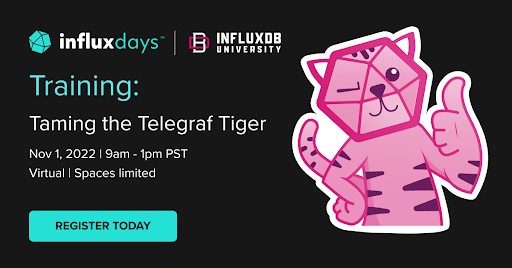A Sneak Peek at InfluxDB University’s Upcoming Live Telegraf Training
By
Susannah Brodnitz /
Product, Use Cases
Oct 24, 2022
Navigate to:
Telegraf, InfluxDB’s open source data collection agent, uses hundreds of plugins to gather data, transform it, and send it where you want it to go. It’s a very powerful tool to incorporate into your data pipeline. If you’ve been wanting to get started with Telegraf but haven’t known where to start, a great way to learn is at InfluxDB University’s live virtual training on November 1st. You can register here for free to learn from experts in a hands-on lab setting. By the time the training is done you’ll be a Telegraf pro and have a digital badge to show for it. This training is part of InfluxDays, our free virtual user conference on November 2-3, 2022. Anyone who signs up for the training will be automatically registered for InfluxDays. Here’s a sneak peek at some of the topics covered in the training.

Understanding Telegraf
During the training you’ll learn about all the things you can do with Telegraf. There are hundreds of plugins for collecting data from sensors, systems, and stacks, but Telegraf goes beyond that. You’ll learn about processor and aggregator plugins that let you filter and transform data before it reaches its endpoint. Processors plugins can do things like print metrics as they pass through Telegraf and add tags to metrics. Aggregator plugins create new metrics, such as running means, standard deviations, or quantiles. You can choose within Telegraf whether to pass through both the original metrics and the aggregates or to drop the originals and just send the aggregate values to your endpoint.
You’ll also get hands-on experience configuring and running Telegraf. The instructors leading this course have designed exercises to give you the skills you need to set up your local environment, configure your cloud environment, and enable plugins to collect and filter data. This training includes several exercises you can complete live, including learning to debug and learning dual writes to send data to two different outputs. The great thing about taking a course live is that you can get your questions answered as they come up, and you can also hear the responses to questions other participants bring up that you might not have thought to ask.
Edge Data Replication
This training will also show you how to use InfluxDB with Edge Data Replication (EDR). Edge Data Replication lets you automatically replicate data from an edge OSS instance of InfluxDB to InfluxDB Cloud. This is great for situations where you want to work with data in detail locally and also in aggregate in the Cloud. For example, a factory floor manager might want to keep tabs on the status of a machine in detail, but a data scientist at the company might want to work with downsampled data from many factories in the Cloud. Edge Data Replication uses a durable queue so it’s also great for situations with intermittent network connectivity. In this training you’ll learn to work with InfluxDB OSS locally and replicate data to InfluxDB Cloud.
If you can’t take the live course but still want to learn more about Telegraf, InfluxDB University has you covered! Data Collection with Telegraf is a free self-paced course you can take to become a Telegraf expert and earn a shareable badge. InfluxDB University also has courses on Flux, InfluxDB Cloud, InfluxDB Enterprise, and more. Don’t forget to register for InfluxDays, There will be some exciting announcements in InfluxDB University in the session on November 3rd. And the Become an InfluxDB Pro in 20 Minutes and Become a Flux Pro are a must see. If you can’t make it live, register for free to get a link to all the on-demand sessions when they become available.
